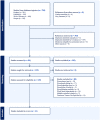Deep learning image segmentation approaches for malignant bone lesions: a systematic review and meta-analysis
- PMID: 37614529
- PMCID: PMC10442705
- DOI: 10.3389/fradi.2023.1241651
Deep learning image segmentation approaches for malignant bone lesions: a systematic review and meta-analysis
Abstract
Introduction: Image segmentation is an important process for quantifying characteristics of malignant bone lesions, but this task is challenging and laborious for radiologists. Deep learning has shown promise in automating image segmentation in radiology, including for malignant bone lesions. The purpose of this review is to investigate deep learning-based image segmentation methods for malignant bone lesions on Computed Tomography (CT), Magnetic Resonance Imaging (MRI), and Positron-Emission Tomography/CT (PET/CT).
Method: The literature search of deep learning-based image segmentation of malignant bony lesions on CT and MRI was conducted in PubMed, Embase, Web of Science, and Scopus electronic databases following the guidelines of Preferred Reporting Items for Systematic Reviews and Meta-Analyses (PRISMA). A total of 41 original articles published between February 2017 and March 2023 were included in the review.
Results: The majority of papers studied MRI, followed by CT, PET/CT, and PET/MRI. There was relatively even distribution of papers studying primary vs. secondary malignancies, as well as utilizing 3-dimensional vs. 2-dimensional data. Many papers utilize custom built models as a modification or variation of U-Net. The most common metric for evaluation was the dice similarity coefficient (DSC). Most models achieved a DSC above 0.6, with medians for all imaging modalities between 0.85-0.9.
Discussion: Deep learning methods show promising ability to segment malignant osseous lesions on CT, MRI, and PET/CT. Some strategies which are commonly applied to help improve performance include data augmentation, utilization of large public datasets, preprocessing including denoising and cropping, and U-Net architecture modification. Future directions include overcoming dataset and annotation homogeneity and generalizing for clinical applicability.
Keywords: CT; MRI; PET/CT; bone cancer; deep learning; image segmentation.
© 2023 Rich, Bhardwaj, Shah, Gangal, Rapaka, Oberai, Fields, Matcuk and Duddalwar.
Conflict of interest statement
The authors declare that the research was conducted in the absence of any commercial or financial relationships that could be construed as a potential conflict of interest. The author(s) GM and BF declared that they were an editorial board member of Frontiers, at the time of submission. This had no impact on the peer review process and the final decision.
Figures





Similar articles
-
Systematic Review of Tumor Segmentation Strategies for Bone Metastases.Cancers (Basel). 2023 Mar 14;15(6):1750. doi: 10.3390/cancers15061750. Cancers (Basel). 2023. PMID: 36980636 Free PMC article. Review.
-
Comparison of atlas-based techniques for whole-body bone segmentation.Med Image Anal. 2017 Feb;36:98-112. doi: 10.1016/j.media.2016.11.003. Epub 2016 Nov 12. Med Image Anal. 2017. PMID: 27871000
-
Deep Learning Prostate MRI Segmentation Accuracy and Robustness: A Systematic Review.Radiol Artif Intell. 2024 Jul;6(4):e230138. doi: 10.1148/ryai.230138. Radiol Artif Intell. 2024. PMID: 38568094 Free PMC article.
-
Comparing different CT, PET and MRI multi-modality image combinations for deep learning-based head and neck tumor segmentation.Acta Oncol. 2021 Nov;60(11):1399-1406. doi: 10.1080/0284186X.2021.1949034. Epub 2021 Jul 15. Acta Oncol. 2021. PMID: 34264157
-
A computational pipeline for quantification of pulmonary infections in small animal models using serial PET-CT imaging.EJNMMI Res. 2013 Jul 23;3(1):55. doi: 10.1186/2191-219X-3-55. EJNMMI Res. 2013. PMID: 23879987 Free PMC article.
Cited by
-
Data-Efficient Bone Segmentation Using Feature Pyramid- Based SegFormer.Sensors (Basel). 2024 Dec 26;25(1):81. doi: 10.3390/s25010081. Sensors (Basel). 2024. PMID: 39796872 Free PMC article.
References
-
- Jayarangaiah A, Kemp AK, Theetha Kariyanna P. Bone metastasis [Updated 2022 Oct 25]. In: StatPearls [Internet]. Treasure Island (FL): StatPearls Publishing; (2023). Available at: http://www.ncbi.nlm.nih.gov/books/NBK507911/ (Cited Jun 5, 2023). - PubMed
Publication types
Grants and funding
LinkOut - more resources
Full Text Sources

